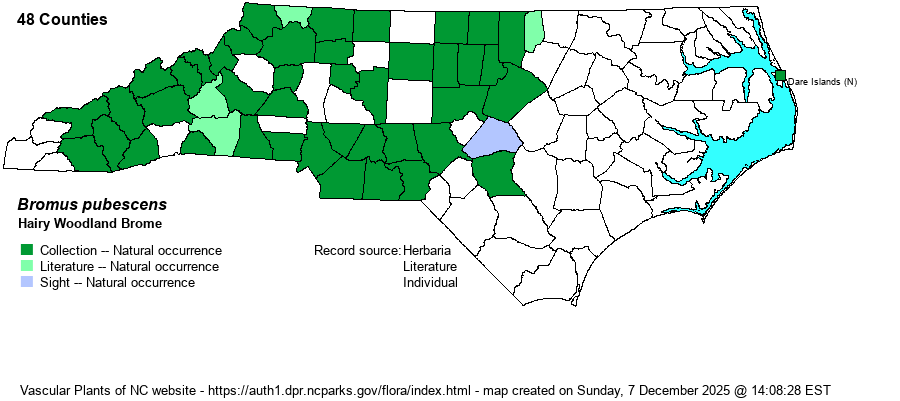| Author | Muhlenberg ex Willdenow | |
| Distribution | Throughout the Mountains and Piedmont; disjunct to the Outer Banks at Nags Head Woods. Records from Harnett and Cumberland counties are from the Cape Fear River floodplain. Absent from the Sandhills proper, as well as nearly all of the Coastal Plain.
VT to southern Man., south to northwestern FL and central TX. | |
| Abundance | Frequent in the Mountains and Piedmont; very rare along the Cape Fear River into the upper Coastal Plain. Disjunct to the Outer Banks (Buxton Woods). | |
| Habitat | Rich mesic forests on slopes or on brownwater river floodplains, maritime forest in shelly soil. Often in rocky sites in upland forests, especially over mafic or calcareous rock. |
| Phenology | Flowering and fruiting late May-August. | |
| Identification | Get to know this native species before you attempt to identify our other native bromes. Our native brome grasses typically grow 3-4 feet tall and have inflorescences with arching branches and drooping spikes. Hairy Woodland Brome has densely short-hairy glumes (vs. glabrous in B. ciliatus); 3-veined upper glumes (vs. 5-veined upper glumes in B. nottowayanus); and 2-9 stem nodes (as do the others except B. latiglumis with its 9-20 nodes).
| |
| Taxonomic Comments | Older references included this within B. purgans. More recent ones have this split out, and with one or two other taxa pulled out of B. pubescens and named as full species.
Bromus is an important genus of grasses for their value as forage (many species) or for the harm they cause to the guts of grazing animals (a few species). In most of our species, inflorescences arch over and cause the spikelets to droop; thus the plants are often graceful looking. Bromus, Festuca, and Poa all can look quite similar to beginners (and even veterans!), because they all have multi-flowered spikelets. Generally speaking, Bromus taxa have much the largest spikelets, and most Poa taxa have a tuft of wispy hairs at the base of each floret (lacking in the other genera). Bromus and Festuca taxa have obvious awns on the florets that are absent in Poa taxa. With field experience and careful use of keys, one can eventually handle these genera. | |
| Other Common Name(s) | Canada Brome, Hairy Wood-brome, Hairy Wood-chess | |
| State Rank | S4 | |
| Global Rank | G5 | |
| State Status | | |
| US Status | | |
| USACE-agcp | FACU link |
| USACE-emp | FACU link |

